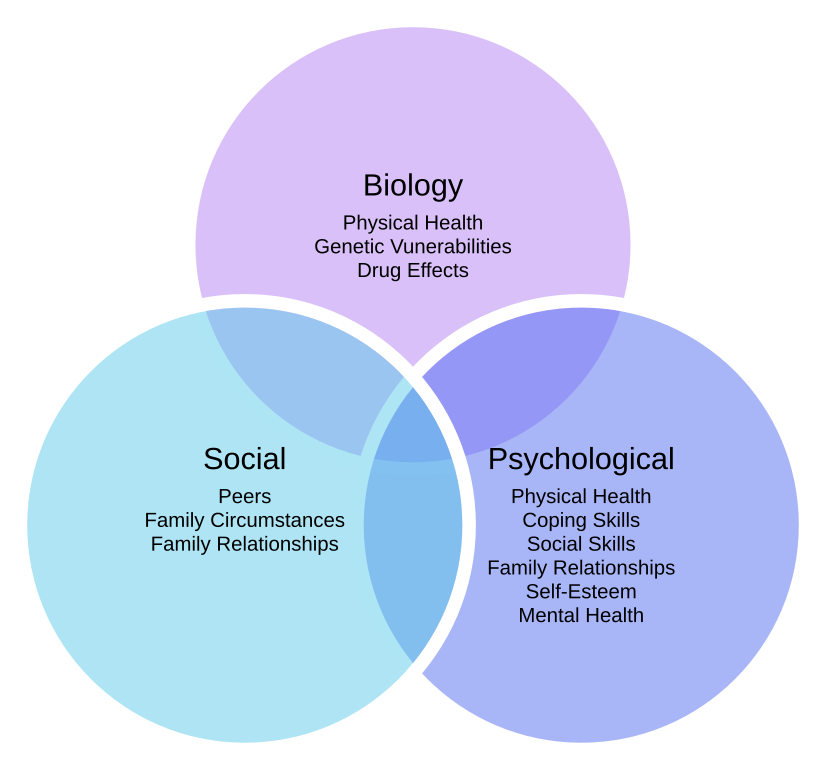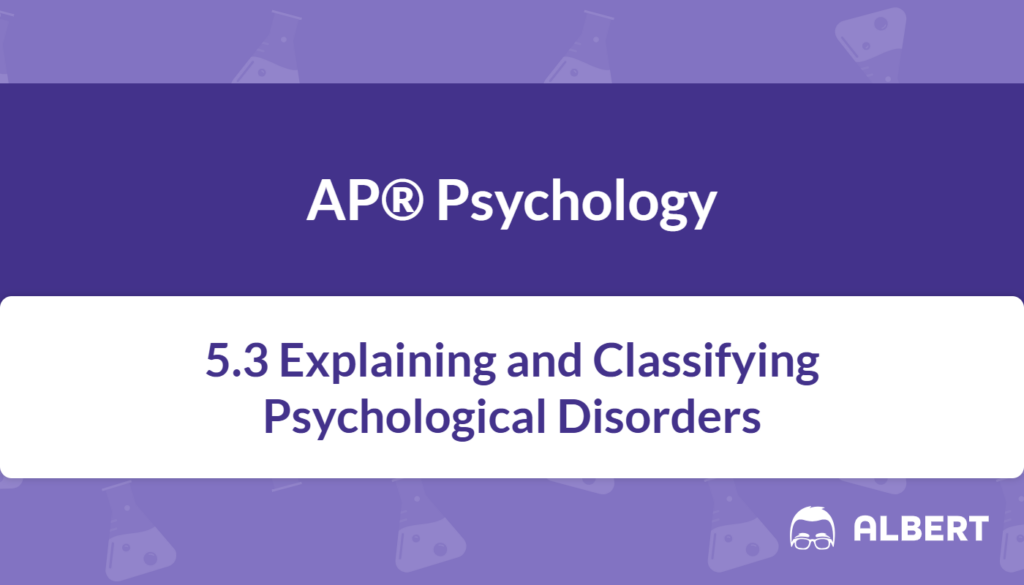What We Review
Psychological disorders can seem complex without the right framework. Therefore, it is helpful to break them down into specific categories and key concepts. This article focuses on diagnosing psychological disorders, classifying psychological disorders, and understanding the role of psychological perspectives in diagnosing. It also addresses how psychological evaluation and interaction models contribute to a clearer picture of mental health. By the end, students will be ready to apply these concepts to real-life scenarios and their AP® Psychology exam.
Introduction
Psychological disorders refer to patterns of thoughts, feelings, or behaviors that lead to distress, dysfunction, or a notable deviation from social norms. These disorders are not merely everyday worries. Instead, they often require careful evaluation using evidence-based tools and professional training. For students preparing for an AP® Psychology exam, understanding these classifications and the various diagnostic perspectives is crucial.
This guide explores what psychological disorders are, how they are classified, and the ways different psychological perspectives play a role in diagnosing. It also delves into the interaction models that combine biological, psychological, and social factors. The goal is to simplify each concept and offer clear examples.
What Are Psychological Disorders?
Psychological disorders encompass conditions that cause significant disturbances in behavior, thinking, or emotion. Specialists often rely on three main factors to identify these disorders:
- Dysfunction: An individual’s normal functioning is impaired.
- Distress: A person experiences serious emotional or physical discomfort.
- Deviation from Social Norms: Behaviors or thoughts deviate from what a culture or society deems typical.
Example: Anxiety Affecting School Performance
A high school student experiences extreme anxiety.
- Identify Dysfunction: Classes are missed due to panic attacks.
- Assess Distress: Persistent worry disrupts responsibilities.
- Consider Social Norms: Mild nervousness is common before a test, but severe, chronic fear indicates a possible disorder.
Practice Problem – Identifying Factors
An athlete always dreads team practice. This fear causes exhaustion, frequent absences, and near-constant worry about letting the team down. Which signs of a psychological disorder are present?
Step-by-Step Solution
- Notice the dysfunction: The athlete stops attending practice and loses focus in school.
- Recognize the distress: Feelings of worry and guilt cause emotional discomfort.
- Observe deviation from norms: Most players feel some nerves, but severe avoidance suggests an abnormal pattern.
Diagnosing and Classifying Psychological Disorders
Professionals often use standardized diagnostic tools:
- DSM (Diagnostic and Statistical Manual of Mental Disorders): Developed by the American Psychiatric Association. It is updated regularly to reflect new research and practice advances.
- ICD (International Classification of Diseases): Maintained by the World Health Organization. It classifies all health conditions, including mental disorders.
Diagnosing psychological disorders can lead to positive outcomes, such as accurate treatment and better access to resources. However, there can also be drawbacks. Stigma, discrimination, or cultural misunderstandings might arise when a diagnosis labels someone. Therefore, the social context and individual background must be considered, as diagnosing psychological disorders involves cultural and societal norms.
Example: Diagnosis of Depression
A person receives a clinical diagnosis of depression.
- Positive Consequences: Gaining formal acknowledgment opens the door to therapy and medication.
- Negative Consequences: Stigma or discrimination may follow, especially if peers misunderstand mental health.
Practice Problem – Weighing Consequences
A teenager is told by a doctor that they have generalized anxiety disorder. The teenager starts therapy but feels self-conscious at school.
- Identify a positive effect of receiving a diagnosis.
- Identify a negative effect of receiving a diagnosis.
- Explain one way that cultural norms may influence the teenager’s experience.
Step-by-Step Solution
- Positive effect: Therapists can create a tailored treatment plan.
- Negative effect: Peers might tease or avoid contact due to stigma.
- Cultural norms: In some communities, mental health conditions may be less accepted, increasing shame or secrecy.
Psychological Perspectives in Diagnosis
Several psychological perspectives help professionals understand the causes of mental disorders. Many practitioners use an eclectic approach, which combines multiple perspectives to gain a full picture of a client’s challenges.
- Behavioral Perspective: Focuses on learned maladaptive responses or associations.
- Psychodynamic Perspective: Emphasizes unconscious thoughts and childhood experiences.
- Humanistic Perspective: Highlights unmet needs or lack of social support.
- Cognitive Perspective: Addresses dysfunctional thinking, beliefs, and attitudes.
- Evolutionary Perspective: Considers how certain traits or behaviors might reduce survival chances.
- Sociocultural Perspective: Examines how cultural and social relationships shape behaviors.
- Biological Perspective: Considers genetic or physiological factors that contribute to mental disorders.
Example of the Eclectic Approach
A therapist helps an individual manage panic attacks by blending two methods.
- Identify Harmful Thoughts (Cognitive Approach): The therapist guides the individual to challenge irrational beliefs about failure.
- Alter Behaviors (Behavioral Approach): The therapist teaches relaxation techniques and gradual exposure to triggers.
Practice Problem – Which Perspective?
A student struggles with low self-esteem and becomes withdrawn. The counselor suspects negative self-talk is at the root.
What perspective best explains the cause?
- Behavioral, Psychodynamic, Humanistic, or Cognitive?
Step-by-Step Solution
- Examine the focus: The counselor believes negative self-talk drives the issue.
- Compare to perspectives: Negative self-talk aligns most with the Cognitive Perspective.
- Conclusion: The counselor is likely using the Cognitive Perspective to address maladaptive thought patterns.
Interaction Models of Psychological Disorders
Some psychologists prefer models that view psychological disorders as the result of multiple factors. Two common approaches are:
- Biopsychosocial Model: Assumes disorders arise from a combination of biological, psychological, and social influences.
- Diathesis-Stress Model: Suggests individuals inherit a predisposition (diathesis) and experience stress that triggers the disorder.
Professionals sometimes express the diathesis-stress model as a simplified formula:
P(\text{disorder}) = \text{Diathesis} \times \text{Stress Level} - \text{Protective Factors}This symbolic expression highlights that the presence of genetic vulnerability plus high stress often leads to a greater risk for a specific disorder. Protective factors like family support can reduce that risk.

Example of the Biopsychosocial Model
Imagine a student experiences severe test anxiety.
- Biological: A family history of heightened stress responses.
- Psychological: Persistent fear of public failure.
- Social: Minimal support from teachers or classmates.
Each layer influences the student’s mental health. Addressing only one aspect misses the bigger picture.
Practice Problem – Applying the Diathesis-Stress Model
A teenager has a family history of mood disorders (diathesis), works late hours, and struggles with stressful exams.
- Identify the diathesis.
- List potential stressors.
- Suggest a protective factor that might reduce the overall risk.
Step-by-Step Solution
- The teen’s family history is the diathesis.
- Late working hours and overwhelming exams are the stressors.
- A strong support system at home or tutoring for better time management can act as a protective factor.
Important Vocabulary
Below is a quick reference chart with key terms and definitions about diagnosing psychological disorders and classifying psychological disorders. Copying and pasting this chart into a document can serve as a handy study guide.
| Term | Definition |
| Psychological Evaluation | An assessment process to determine mental health status. |
| DSM | A manual for classifying mental disorders, used primarily in the United States. |
| ICD | An international standard for health conditions classifications, including mental disorders. |
| Dysfunction | Impairment of normal functioning in personal, academic, or social domains. |
| Distress | Emotional suffering that disrupts daily life activities. |
| Deviation from Norms | Behaviors or thoughts that significantly differ from what society considers typical. |
Conclusion
Understanding psychological disorders requires more than memorizing definitions. It involves recognizing when thoughts or behaviors cause distress, dysfunction, and deviate from expected norms. Diagnosing psychological disorders and classifying psychological disorders helps ensure individuals receive the right support, even though diagnoses can carry both advantages and drawbacks.
Psychological perspectives—whether behavioral, cognitive, or biological—provide various lenses to see the causes of mental disorders. Yet, neither genetics, learned behavior, nor cultural context alone is enough. The interaction models, such as the biopsychosocial or diathesis-stress approaches, illustrate how multiple factors overlap.
By mastering these concepts, students will be equipped to handle exam questions and better appreciate real-life mental health complexities. Additional resources, such as official DSM or ICD guidelines, can further expand learning and encourage a deeper understanding of mental health care.
Sharpen Your Skills for AP® Psychology
Are you preparing for the AP® Psychology test? We’ve got you covered! Try our review articles designed to help you confidently tackle real-world AP® Psychology problems. You’ll find everything you need to succeed, from quick tips to detailed strategies. Start exploring now!
- Positive Psychology Definition: AP® Psychology Review
- Defining Psychological Disorders: AP® Psychology Review
- Mental Health Service: AP® Psychology Review
Need help preparing for your AP® Psychology exam?
Albert has hundreds of AP® Psychology practice questions, free response, and full-length practice tests to try out.








